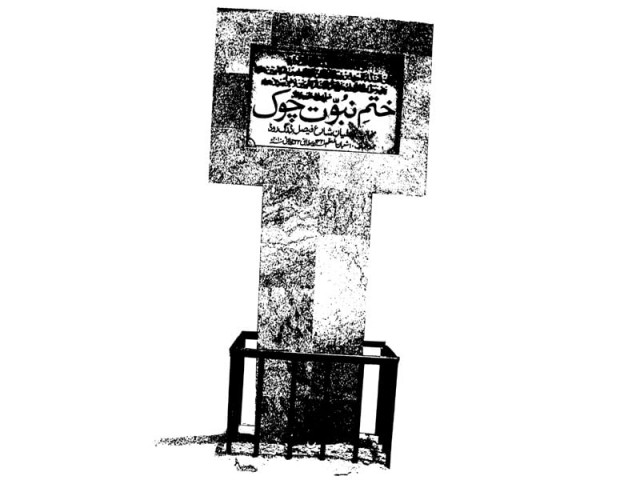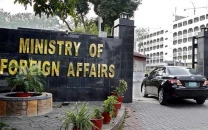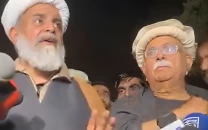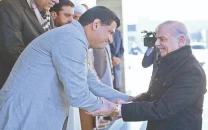Ahmadis in Karachi: Pulpit pounding, barricades, prayers but no peace
The minority has been under constant attack even though it keeps a low profile.

On a Friday afternoon, there is pin-drop silence around the Ahmadi place of worship in Karachi’s Drigh Road area. Worshippers quietly enter through a side door, watched over by a number of men on patrol and security cameras affixed to the building.
Just down the lane, the imam of Bilal Masjid peppers his sermon with anti-Ahmadi remarks. The strains of his sermon can be heard throughout the neighbourhood, including the men standing guard outside their place of worship.
Friday prayers are under way in both buildings, but only one congregation is allowed to practice its faith openly.
At the crossroads of the mosque and the place of worship is a marker for the ‘Khatm-e-Nabuwwat’ roundabout, a silent but potent public reminder of the power of the religio-political party in Pakistan. “There was a rally here a few months ago,” recalls a resident. “About 2,000 people attended and it was organised by the Tahaffuz Namoos-e-Risalat movement. They reaffirmed their faith in the finality of the Prophethood (peace be upon him), and then decided to rename this roundabout as a memento of the rally. After all, we are all Muslims, this is our faith.”
Sunni Tehreek (ST) flags flutter in the area, whose walls are covered with grafitti, declaring the area to be Sunni Nagar. “These clerics, Sunni Tehreek… they’re all one and the same,” remarks a shopkeeper who has worked near the Ahmadi place of worship for 25 years. He has witnessed the area’s clerics raging against the Ahmadiyya community for placing barricades near their place of worship. There have been incidents of firing in the area as well. Thoughtfully, he says, “The problem is that Muslims have increasingly become intolerant.”
A poster for a June 2 Tahaffuz Namoos-e-Risalat conference is still plastered to the wall of the Ahmadis’ building. A few months ago, activists reportedly barged in and demanded that the Kalima, a verse declaring Muslim faith, be erased from a wall within the place of worship’s premises.
“This centre has been here since before you or I were born,” says the shopkeeper. Another resident said it was at least 40 years old.
Attendance at prayers at Ahmadi places of worship in Karachi has slowly picked up after the 2010 Lahore attacks. “We have stopped women and children from coming to the centres because we fear that they will be targeted first, similar to the Lahore attacks,” says Masood Khan, a senior representative of the Ahmadiyya community. “Praying is also difficult and it gets quite suffocating - we have to close all the windows and doors so that no sound can be heard outside.”
Outside is where a mob — literally and physically —exists. Just like the cleric at Bilal Masjid, mosque speakerphones are regularly used to incite hatred.
While Punjab has been the breeding ground for anti-Ahmadi sentiment, the minority in Sindh faces targeted assassinations, discrimination and blasphemy cases filed on flimsy charges. Reviled due to a decades-old campaign, Ahmadis have nowhere to turn to, not even the state. A lieutenant, who was awarded the Sword of Honour, was forced to leave the navy because his faith meant he would never be promoted. A woman was widowed twice because her husbands were practicing doctors. Flyers are openly distributed, asking people to boycott Ahmadi-run businesses and execute their owners.
“We have brought these incidents ... to the police’s notice so many times,” says Khan. “But they do nothing beyond occasionally sending a policeman or two.”
The police also have their own biases. Khan recalls that two officers refused to drink water offered to them by Ahmadis. “The Central Investigation Department has several men in its custody who confessed that they wanted to target Ahmadis and Shias. But they have never been presented in court.”
Even then, Khan says, the police in Karachi are better than those in the Punjab. Khan praises former Sindh home minister Zulfiqar Mirza for proactively listening to their problems. “The police will at least send someone. The security apparatus was concerned after the attacks in Lahore and we discussed measures. But we asked for Rangers to be deployed on Fridays and that has not happened.”
After a lifetime spent in fear, Ahmadis in Karachi who can afford to relocate are packing up their bags. At least 300 to 400 people have reportedly left. The Ahmadiyya community in Karachi is at least 20,000 strong.
Others hail from rural Sindh, especially Sanghar. This district has seen numerous cases of violence and Section 295-C cases (which carries the death penalty) filed by a cleric, Maulana Hamadi. “[He] sits in Sanghar and files cases against people sitting miles away in Rabwah!” exclaims Qaiser Shahzad, a Karachi-based businessman.
In Karachi, Ahmadis living in Mehmoodabad have been gunned down in the past decade, with up to six cases in the last three years alone. One of them included a doctor who chose to work in the poor area. He was killed as he stopped at a speed breaker on his way home. Twenty-five families from Manzoor Colony have emigrated.
“We don’t tell our children that they will face discrimination. We don’t want to poison their minds at a young age,” Khan says. “But at school they are inevitably discriminated against. Our girls come back home and say they don’t want to go to college.”
Ahmadi families prefer sending their children to schools run by Parsis and Christians - also minorities. According to Shahzad, admissions are a no-go once school realise what the family’s faith is.
Intolerance has spread to other areas as well. In Badin, an Ahmadi centre was targeted during an event for women. Incited by a cleric, men besieged the centre for eight hours. It took Zulfiqar Mirza (who was elected as an MPA from Badin) to clamp down. In January, a leaflet threatening an Ahmadi businessman was circulated in Goth Saban Dasti in Badin, which stated: “Such an apostate should be killed and his business should be banned all over Pakistan. We demand that the government of Pakistan take immediate action, otherwise the people will have to do this job on their own.”
Karachi’s business community, according to Khan and Shahzad, is generally accepting of Ahmadis, especially those whose operations have been established for decades. However, Shahzad says in a resigned tone, “You can tell the difference in the way they meet us. They work with us because they have to.”
Discrimination has also swept the armed forces and civil bureaucracy. “From Chaudhry Zafarullah to high-ranking generals, Ahmadis were always represented in the top ranks. But now we barely have a few people at top positions in the civil bureaucracy. In Ziaul Haq’s era, this [discrimination] was implemented — there are no promotions. Ahmadis don’t even clear interviews for government or military jobs now, despite being highly qualified.”
Discrimination, Khan says, is also found among old friends. “I know that they don’t want to dine with me.”
“Look, people believe that we are wajibul qatl [liable to be killed]. This thought is reflected in our assemblies.”
Anti-Ahmadi sentiment and extremism, the men said, has increased in society over the past few years. Laws pertaining to Ahmadis — particularly those introduced in the 1980s — have provided legal backing to the hate being propagated in society. Anti-Ahmadi graffiti routinely appears near places of worship, and the gate of one building was fired on recently in Steel Town. Yet, Khan and Shahzad say, they have learned to live with the ever-present fear. “We are sitting openly,” says Khan. “But someone has to come forward on behalf of the community. We don’t consider ourselves minorities. We are Pakistanis. This is our country.”
Legal exclusion
In 1952, religious parties demanded the removal of Pakistan’s first foreign minister, Sir Chaudhry Zafarullah Khan, who was an Ahmadi. In 1974, after violent demonstrations took place, Jamaat-e-Islami factions demanded that Ahmadis be declared non-Muslims. A constitutional amendment was passed to exclude Ahmadis from Islam. In 1984, amendments were made to ban the usage of Islamic symbols and practices for Ahmadis, such as calling their places of worship a mosque.
Source: International Crisis Group report: ‘The State of Sectarianism in Pakistan’, Jinnah Institute report: ‘A Question of Faith’
A profile
The Sunni Tehreek is a religio-political party that follows the Barelvi school of thought. It has actively campaigned against any amendments to or repeal of the country’s blasphemy laws. ST activists protested against Punjab Governor Salmaan Taseer prior to his assassination on June 4 and have supported his assassin Malik Mumtaz Hussain Qadri.
Published in The Express Tribune, June 19th, 2011.
COMMENTS (158)
Comments are moderated and generally will be posted if they are on-topic and not abusive.
For more information, please see our Comments FAQ



















Harsh but true picture of our current society. Thanks tribune for this beautifull piece of writing.
GOD bless you. Love for all, hatred for none.
Salam Saba
May Allah Ta’ala help Pakistan. It is this notion of extremism introduced by Zia that has led Pakistan to its current state of fundamentalism and intolerant society. I hope the people of Pakistan start realizing what true Islam is instead of blindly following Islam of Zia and mullah…… Real Fact.First of all thanks for hi-lighting the true facts which are faced by Jamaat Ahmadiyya in Pakistan. Due to this continued hatred, without knowing and reading the truth of Jamaat Ahmadiyya, Our Country is suffering from Many diseases like Terrorism, Racism etc. Following the Mullah's teachings of hatred and killing without knowing a single line of Quran e Pak is becoming a part of beliefs of common people. And due to this fact It is indeed a curse by Allah on whole society that people are killing each other without knowing who is he and what was his mistake.
Thanks to TRIBUNE
its nice to know that some people have the courage to condemn the wrong against Ahmadies.
Ahmadies played very important role in the struggle for achieving Pakistan: its just lack of knowledge to say that Ahmadies were not in favor of Pakistan . Ahmadi in Army also played crucial role in war against india. Due to bias against us non-ahmadies do not give us any credit. But we are true Pakistanies and we will never stay back when our country need us in any trouble; just like Humanity First our organization helped victims of last year floods and many other social works carried out during any time in an year.
I dont know why Mullah is spreading hatred among people??? Are they here to spread love and peace or to spread hate and unreset.... I can't find any example like this in the whole life of Muhammad PBUH..Why they are more concerend about deciding Ahmad's relegion instead of making their own reglegious belives strong????
THNX JAZAKALLAH tribune :)
TRUTH speaks itself, just we have to accept that
Jazak Allah Saba Imtiaz, You have done a daring job by writing and highlighting such an important issue in Pakistan by which we as a nation suffering and passing from the worst phase of this era. Keep doing such gallant jobs by using your pen. May Allah bless you and Tribune by publishing such an intrepid article.
I would like to appreciate this brave effort of tribune, the way tribune has expressed the issues of Ahmadi Jamat. Pakistan is a country where the majority follows the religion Islam. Islam is the religion of peace and it allows all the beliefs to follow their practice independently, whereas in Pakistan it is seen that the people have become very much intolerant and extremist. Ahmadi belief, which has a motto, “Love for all hatred for none”, has proved it at the time, when their mosques were attacked by terrorists, they didn't show extremism or violence. They peacefully negotiated the issue with the government rather than marching on streets or lighting the public property. Following the religion of Islam, all the Muslims should remember that the prophet Mumammad S.A.W. was the prophet of peace and he practiced peace before or after the Fateh of Makkah.
As far as I remember, loud speakers were banned to use for such sermons, in which element of religous hatred is found.... Loud speakers are supposed to use for Azaam purpose only. Surpringly, on one hand, same is used for a noble cause, azaan.... on the other hand, used for hate... are they humans??? in shape of mullahs... should they be called humans?
This article is definitely thought provoking and it makes me wonder. It makes me wonder how easily we forget our foundation and the basis on which this country was formed. After reading the above article it is debatable whether the people even remember “Mohammad Ali Jinnah” leave aside his teachings. In his address as President of the Constituent Assembly he said; “You are free; you are free to go to your temples. You are free to go to your mosques or any other place of worship in this State of Pakistan. You may belong to any religion or caste or creed that has nothing to do with the business of the State.” It really does make me wonder as a Citizen of this country whether Mr. Jinnah did mean anything to this country. I have not seen him or the people of his time, but his name is all over the history, and it makes me wonder how his teachings fit in the equation of letting only a ‘section’ of the public practice it’s faith freely. The Ahmadies do not demand that others should believe or accept their teachings but, that they should also be duly respected and identified as a ‘citizen’ of this country. A citizen no more or less than the others. This however, is not possible until and unless the government repeals the Second Amendment to the Constitution of Pakistan passed in 1974 and 298 B and C of the Pakistan Penal Code. These provisions are clearly incompatible with Article 20 of the Constitution which is freedom to profess religion and to manage religious institutions. Not to mention that these additions to the penal code were brought about in the dictatorial period of Zia-ul-Haq, where to call for democratic arrangement was itself subject to questioning. I hope the people of the country soon realize how it is to live in a country, in a homeland you belong to but still cannot call it ‘yours’. O ye. Remember, that all men are born equal and shall die equal!
I don't find a single evidence in the life of Hazrat Muhammad (P.B.U.H) when he ordered to kill anyone just because of his faith, unless in a battle when someone attacks Muslims then it is allowed to defend yourself.
But here the situation is much worst. We being Ahmadi Muslims do believe in the Last Shariah of Hazart Muhammad (P.B.U.H) and lend our lives exactly according to that BUT still are being killed, tortured and continuously discriminated in all parts of society just because we follow the true Islam.
Now look at the life of these Mullas who are so called defenders of Islam, can you find any single of them following true Islam in their lives. The answer is a Big NO.
The choice is yours, everyone has to answer to Allah for his own deeds. Think yourself don't blindly follow your Mullah.
Brilliant! Jazakallah
Exceptional work ET,Pakistan fiercely needs bold people who can speak the truth.
AOA, May Allah bless on this nation, give them eyes of real islam and May this nattion follow the foot marks of Holly Prophit PBUH. He teaches us tolerance and forgivness.
thnx tribune...
Islam is a religion of peace. Islam preaches love and tolerance. Molvis preach hatred and barbaric acts in the name of Islam. Doesn't a reformer required?
Very Good Article. Thx tribune.
This is absolutely a brilliant and courageous effort by both writer and Tribune to publish a report on such critical issues. Nowadays, Pakistan is badly hurt by such So Called Religious parties. And the laws made against Ahmadies, spread hatred all over the Pakistan. Pakistani people should realize that Islam does not say what these parties declares. People should recite Quran and Hadeeth to know the truth and the real teachings of Islam. Islam wants peace in the world but in Pakistan, Islam is producing hatred. Is it justified?? Definitely not. Lets pray and put our efforts to know our religion. May Allah enable us to do so. At the end, I want to thank Tribune and the writer to raise the voice of innpcent Ahmadies at such level. Jazakumullah.
We are facing hatred from everywhere in Pakistan. But Allah makes some people to express the truths what their eyes can sight. Its a brilliant and courageous effort by the Essay writer as well as the Tribune. Jazakumullah. May Allah enable you to disclose more truths.
Excellent piece.
We need to educate Pakistan's children that intolerance and hate towards different creeds is unacceptable. Bigotry, violence and injustice are not a part of Islam.
Can someone guide me to know: 1. What is the meaning of Islam and what are its fundamental principles? 2. What was the OSWA of Hazrat Muhammad s.a.w towards minorities and what was Hazoors' s.a.w intensions against miniorities, if any? 3. Do we have any single example of snubbing minorities in OSWA?
@safir: "delegation of sikhs and qadianis went to see last lord mount to ask him give them a seprate counties..."
Care to provide any reference? I bet you can not.
Great Artical, good on ya mate. After all those attrocities and discreminations, we still not only love Pakistan as being our homeland but pray for it as much we can. When an Ahmadi gets hurt by fellow countrymen they find solace by praying to Allah to whom they truly believe in, and their resolve gets stronger and their belief in Allah gets strength. May I suggest for once to my beloved people of Pakistan to atleast trust in Allah, pray to Him. I am pretty sure He is better resourced than human being, to whom He created. Please for God sake for even all other matters of life TRUST IN ALLAH who is the creator. In the end I would suggest the writter of this artical to track the Khatme Nabuwat people and write their side of the story as well .......why do they do this all the time and their achievments. Their true faces should be shown to the fellow countrymen. God bless Pakistan.
That was an awesome piece. Efforts of Express Tribune to tear apart that filthy layer of intorence in Pakistan's social fabric is highly appreciated! May the arrive soon when people get weighed by the value of their character rather than the color of their skin or the smell of their faith!
@Fahad Raza: At certain times the specification get inevitable especially when the law singles out a group of people and label them as "non-muslims" despite all their claims and proof of those claims about their being Muslim. You'll never find a Christian saying himself a Muslim or wanting to be called so but all Ahmadis are and claim to be Muslims. And the law of the land is always respected and followed but mind the fact that its a man-made law, not a God-given law that should'nt be questioned at all. The people who made that law were'nt prophets or sages!
Islam gives us the best way, in fact far much better than any other ideology,thought or religion but unfortunately the true Islam has simply been vanished away from our country.
Anyhow Thanx a lot Express Tribune for publishing such a nice article and putting some light on the anti-humanitarian activities being carried out on this land which is none other's but our home land and such activities should be discouraged for the sake of peace and betterment of humanityin our home land.
Thankyou very much
If only Jinnah was alive today. Would have been shocked to see the state we are in. I don't think this is about religion or faith anymore. Seems to me that this is some agenda far more materialistic. And with plenty of illiterate people ready to follow the band wagon, a perfect setup. Well written indeed.
Jammat Ahmadia's message is simple and straight forward for all world, "Love for all, Hatred for None". I pray to god that at least every body comprehend this message.
Great and courageous article. Unless we Pakistanis show ZERO tolerance to extremism, the war against terrorism cannot be won. ZERO tolerance requires the Government to act against those illegal provocations and instigation against any sect.
I really appreciate the efforts of tribune for revealing the truth. Now a days in Pakistan it’s really hard to speak/write about actual picture of our society. In daily life we see many incidents around us for intolerance and injustice but we keep quiet and don't bother to stop or protest it. Only Ahmadi's are not the target of these extremist it is tough for christens, Hindus, Sikhs and all minorities to live in current Pakistan. For Pakistan all these people did there maximum efforts for rebuilding this country. Government/Civil Society is not planning any concrete measures to keep these peoples as part of Pakistan. And let them live there lives according to there faith. I wish Tribune will keep this courage to speak about truth. thanks.
I would like to appreciate this brave effort of tribune, the way tribune has expressed the issues of Ahmadi Jamat. Pakistan is a country where the majority follows the religion Islam. Islam is the religion of peace and it allows all the beliefs to follow their practice independently, whereas in Pakistan it is seen that the people have become very much intolerant and extremist. Ahmadi belief, which has a motto, “Love for all hatred for none”, has proved it at the time, when their mosques were attacked by terrorists, they didn't show extremism or violence. They peacefully negotiated the issue with the government rather than marching on streets or lighting the public property. Following the religion of Islam, all the Muslims should remember that the prophet Mumammad S.A.W. was the prophet of peace and he practised peace before or after the Fateh of Makkah.
After a longtime, it had been seen that any newspaper have the ability or try to think about others. Its been a great effort by SABA IMTIAZ to write what actually it was. I heartedly appreciate Tribune for this positive intent.
there is something to cheer about at last..not actually the article only but the way writer has expressed his views..ahmadis as we all know them are more peaceful than any other community around..while i say this,i have may 2010 incident to quote when dreams of a number of families were shattered but not a single stone was lifted and thrown..there is always a need to spread such message which actually is the message of each religion..but unfortunately this message is spread by a community declared as non muslim..such is the destiny of our nation and it is been depicted everywhere in the country..may Allah enable our leaders to think about it..however i really appreciate the writer..Allah bless us all..
Very Good Article. Thx tribune.
Tribune is doing its job bravely. Hats off to the writer and tribune to publish such article.
A very good and daring approach I must say by Saba Imtiaz. We sincerely appreciate the time you and your team spent on this article. Whatever you have observed and written in the article is true and unbiased to its very core. It is not a hyperbole here if I say that your article, has been the highlight of the day and the media should discuss various inputs that you have given in your article on different angles of the subject ‘Human Rights' or AN AHMADI's RIGHTS in Pakistan. This is all nothing but your encouragement and we profusely thank you once again for your speech.
May Allah protect Pakistan and rest of the world always.
Thanks Tribune for this great effort of highlighting the basic human issue. Brutal truth that those who actually pray and do good deeds as per actual Islam are not allowed to perform prayers freely. Have faced the same attitude from some people throughout student life and still facing this unbearable attitude in the professional life as well. I Love my country, I pray for the long live of Pakistan. I wish the peace and harmony for my country where everyone should have the right to live with the peace of mind and have freedom to live FREE without any restrictions.
I appreciate to tribute and particularly the writer who broken the ice. As we all are well aware of situation in our country, which I totally blame to ourselves that what are our ethics, responsibilities, commitments, acts and what we are doing and what we are not doing so. I should say it is a eye opener for all of us after reading this article but for those who are not biased and trust on peaceful life. It is an inherent human responsibility for each of us to try to make a positive difference in the world and off course WE CAN DO as nothing is impossible.
This has been long awaited. I am amazed how people have kept quiet after the atrocities showed on 28 May 2010 in Lahore at Dar ul Zikr. Few of them showed some sympathies but that was just for the moment. I am thankful to Tribune for showing such courage to publish such articles based on true facts. Keep it up.
A wonderful article and all praise and congrats should go to Sabah. As religion is being used by many to divide society and its results are far more devastating than any one could imagine. I think its very wise for our Journalists to promote and make aware to the masses about the causes and the seeds of religious hatred.
Ahmadis have been the most suppressed and all limits of barbarism have been crossed both by society and by the government. Still they cry in front of God and abide by all laws, their action are far more superior than any words. Still everyone turns a blind eye to them, they were the first to be religiously legislated against and the rights of practicing a religion taken away. Until this first wrong step by the legislators is reversed, the society cannot go back to a unified one and thus creating the foundations of a nation.
No matter what we do until we turn this stone and eradicate the wrong doing of the past, we will not be the same nation again.
I appreciate Tribune for showing courage and highlighting such hatred-spreading campaigns in the name of Islam. These is no doubt that in Pakistan, Ahmadis are passing through the most difficult time of their lives. No steps from local or national government, no attention to news like this, no steps to condemn such acts at media and most importantly nothing from the so called 'independent justice' at all.
One day Pakistani Martin Niemoller will recite as follow; When the Mulla came for the Ahmadis, I remained silent; I was not a Ahmadi.
When they locked up the progressives, I remained silent; I was not a progressive.
When they came for non-Muslims, I did not speak out; I was not a non-Muslim.
When they came for the Shia, I remained silent; I wasn't a Shia.
When they came for me, there was no one left to speak out.
@ Akber We Ahmadis hold a firm believe that loyalty to our country comes first. My grandfathers fought in Kashmir with furqan force, then again in 65 and 1971 where my Nana was a P.O.W along with my chacha. My father was involved in many army operations in his career including the one in Sindh. Yet you have the audacity to question our loyalty towards this country. Let me remind you that it was in the Ahmadiyya mosque of London where Quaid-e-Azam announced he was returning to India.
And what's that supposed to mean!!?? - that we Ahmadi are unable to love, forgive or something?
Care to clarify?
The Children of FEAR, SWALLOWS….. HATE, ANGER & KILLING Easily, But finds themselves INCAPABLE of….LOVE, PEACE & FORGIVENESS.